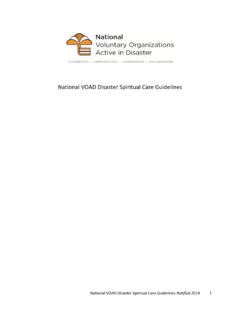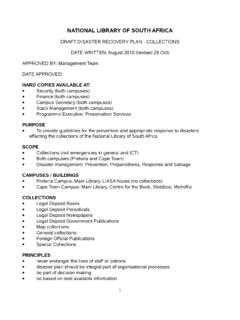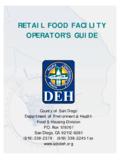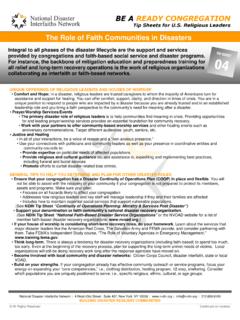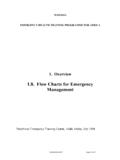Transcription of Preparedness Response Recovery Prevention - …
1 Preparedness Response Recovery Prevention Emergency Action Plans for Retail food Establishments Practical guidance for retail grocery and food service establishments to plan and respond to emergencies that create the potential for an imminent health hazard. Produced by Detroit Department of Health and Wellness Promotion Macomb County Health Department Michigan Department of Agriculture and Rural Development Michigan Restaurant Association Oakland County Health Department Ver 2017. Available electronically at 1. Emergency Action Plans Table of Contents Introduction 5 Responsibilities of the Permit Holder and Regulatory Authorities During an Emergency 6 Planning Ahead Emergency Action Plans for 13 Interruption of Electrical Service 21 Interruption of Water Service 29 Contaminated Water Supply (Biological). 37 Sewage Back-up 47 Fire 55 Flood 63 Vomit and Stool Cleanup Legal Authority 69 food Code/ food Law Authorities Emergency Contact Information 75.
2 Summary of Changes: Only edits to reflect structural changes within the Michigan Department of Agriculture and Rural Development, updates to weblink, and legal citations have been made. 3. Emergency Action plan Introduction Responsibilities of the Permit Holder and Regulatory Authority During an Emergency Permit Holder Single Event In the event of an imminent health hazard involving interruption of electrical service, water service, contaminated water supply, fire, flood, or sewage back-up at an individual establishment, the Permit Holder shall: 1. Assess the situation. Immediately discontinue operation if a safe operation cannot be maintained using an alternative procedure. 2. Notify the regulatory authority of the imminent health hazard and discuss alternate procedures to be used. Determine if the issue is widespread. 3. Follow the appropriate emergency procedures if approved by the regulatory authority or remain closed until granted approval to re-open by the regulatory authority.
3 Widespread Emergency In the event of an imminent health hazard involving interruption of electrical service, water service, contaminated water supply, fire, flood, or sewage back-up that affects numerous establishments, the Permit Holder shall: 1. Conduct an evaluation of the operation as it relates to the hazard to determine if a safe operation can be maintained in accordance with the Michigan food Law 2000. 2. Close the establishment if a safe operation cannot be assured. 3. If a safe operation can be assured, the establishment can remain open provided the appropriate Emergency Action plan (EAP) is followed. 5. Regulatory Authority The Regulatory Authority will: 1. Promptly respond to single events involving imminent health hazards and provide guidance to help the permit holder resume operation as quickly as possible. 2. Allow permit holders to assess food safety within their individual establishment during a widespread emergency and allow the permit holder to follow the Emergency Action plan .
4 3. Communicate with the industry during widespread emergencies through mass media, hot lines, websites, etc. 4. Conduct surveillance during a widespread emergency to determine if permit holders are following Emergency Action Plans. 5. Conduct enforcement activity as appropriate to protect public health. Emergency Action plan Introduction Planning Ahead It is important to plan ahead and be prepared. You should consider the type of hazard(s) for which your business is most vulnerable and take precautions to minimize the impact of such occurrences. For example, of the imminent health hazards listed in this document, statistics show that interruption of electrical service is likely to be the most common. Ask yourself what would you do if your establishment lost power today? What would you do if the power outage lasts for an extended period of time, is widespread, and causes many people to compete for ice, batteries, generators, refrigerated trucks, Would your business survive?
5 According to the National Archives and Records Administration: 43% of companies struck by disaster never resume operations. 29% of those that resume business fail within two years. The high cost of paying staff who are idle, cost associated with loss of staff, added work and material costs related to the disaster, loss of inventory, other hard cash costs, lost business, lost customer loyalty, and lost customer confidence all take a toll. 6. The following checklist is intended to help you start your emergency Response : Water Supply Related Issues Prepare an emergency menu, including recipes for food items requiring no water or minimal amounts of water to prepare. Maintain an inventory of single-service and single-use articles to help get through a reasonable time period. Maintain an inventory of bottled water. Maintain an inventory of containers suitable for hauling water. Maintain an inventory of disposable gloves and hand sanitizer.
6 Develop a business agreement with a bottled water supplier or a licensed drinking water hauler that will provide assurance that you will have an alternative source of water available during an emergency. Locate public water supplies in your area and points where containers can be filled with drinking water. Develop a contingency plan for toilets. If the water service is interrupted,where will you and your employees find toilet facilities available for use? Develop a business agreement with an ice supplier in order to ensure you that you have access to ice during an emergency. Maintain contact information for people such as your plumber, water well drilling contractor, utility company, ice supplier, water supplier, local health department, Michigan Department of Agriculture and Rural Development (MDARD), emergency broadcast station frequency numbers, etc. Develop a list of equipment that uses water and develop a contingency plan describing what you would do if the water is either interrupted or contaminated.
7 Use the Emergency Action Plans as a guide to help describe the steps that you would take in your own establishment. 7. Interruption of Electrical Service Power outages are the most frequent type of man-made disasters. Statistics indicate the average power outage lasts four hours. The August 2003 power outage disaster affecting large areas in the northeastern part of the United States lasted four days. Consider access to an electrical generator that could be used in emergencies. Make certain the generator has the capacity to operate critical pieces of equipment such as refrigeration and freezer units, pumps, safety lighting, hot water heaters, etc. Make certain individuals are trained to operate the equipment safely. Inform the utility company you are using a generator as a safety precaution for their employees. Consider securing access to a refrigerated truck that can be delivered to the site during an emergency.
8 Consider securing access to a refrigerated warehouse that has a back-up generator where you can bring food needing refrigeration in insulated containers. Prepare an emergency menu in advance including recipes for food items that do not require cooking since the ventilation system will no longer remove smoke, steam, grease-laden air, etc. Develop a plan for minimizing loss of food product held under refrigeration. Opening refrigeration equipment doors will cause the food to warm more quickly. What is your strategy for loss Prevention ? If you plan to use ice to keep food cold, where will you obtain ice when ice is in high demand by the general population? Dry ice should not be used in enclosed spaces ( walk-in cooler) because of the potential build-up of carbon dioxide. Heating, air conditioning, security systems, computers, cash registers, lighting, and other systems may not operate. Develop a plan for coping with these problems.
9 Maintain contact information for people such as the utility company, garbage hauling service, ice supplier, 8. refrigerated truck company, food warehouse, septic tank pumping service, local health department, MDARD, emergency broadcast station frequency numbers, etc. Develop a list of equipment that uses electricity in your establishment and develop a contingency plan describing what you would do if electrical service is interrupted. Use the Emergency Action Plans as a guide to help describe the steps you would take in your own establishment. Sewage Backup Develop a list of equipment and facilities that have a drain. What specific steps would you take if each piece of equipment or a combination were no longer operable due to a drainage problem? Use the Emergency Action Plans as a guide to help describe the steps you would take in your own establishment. Develop a contingency plan for toilets. If the drain no longer functions, where will you and your employees find toilet facilities available for use?
10 Maintain contact information for people such as the plumber, drain cleaning service, utility company, septic tank pumping service, local health department, MDARD, etc. Develop a plan for communicating with key people in your organization. Keep a list of emergency contact numbers with you at all times. o Consider the purchase of a phone that plugs into a jack vs. one that depends on electricity for operation. o Utilize a service that can provide continuous communication in the event of a power outage. o plan how important documents and other information will be communicated without the use of computers and fax machines. 9. In Case of Fire Post the phone number of the fire department in a conspicuous place by each phone. Ask the local fire marshall or other authority to conduct an assessment to determine if there are any fire hazards. Develop a plan for what to do in case of a fire. Have a practice fire drill. Ensure your fire extinguisher is charged and hood systems inspections are up to date.










